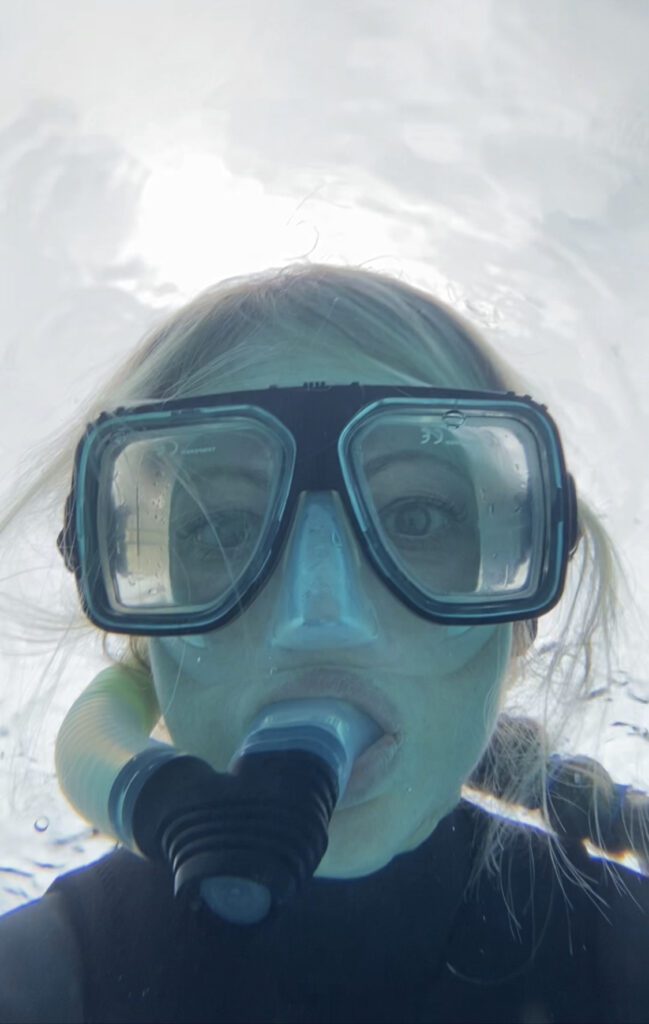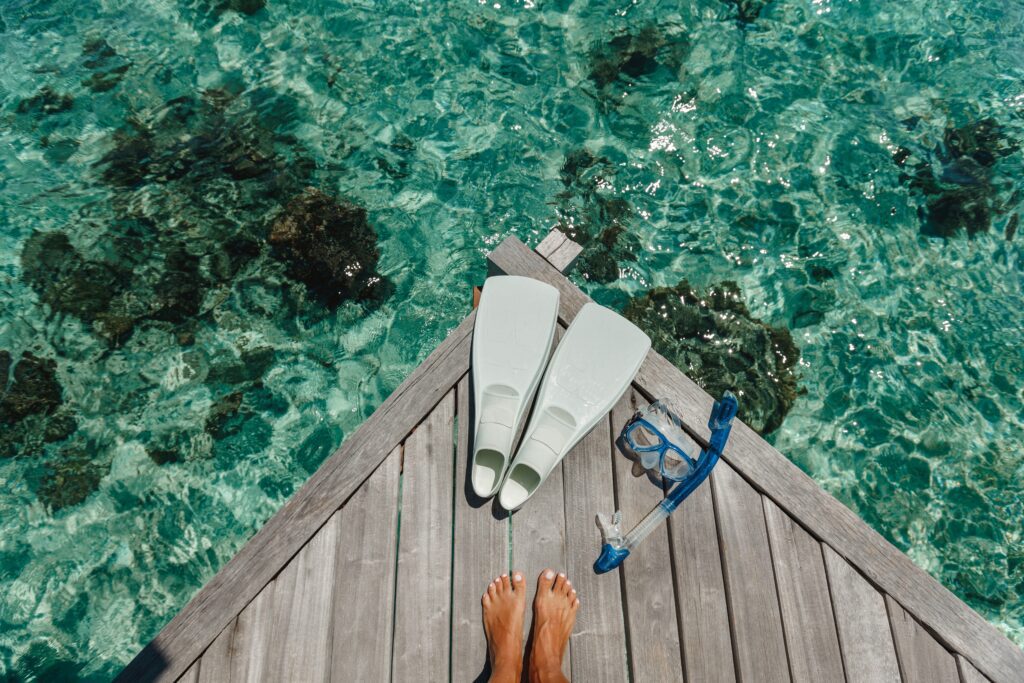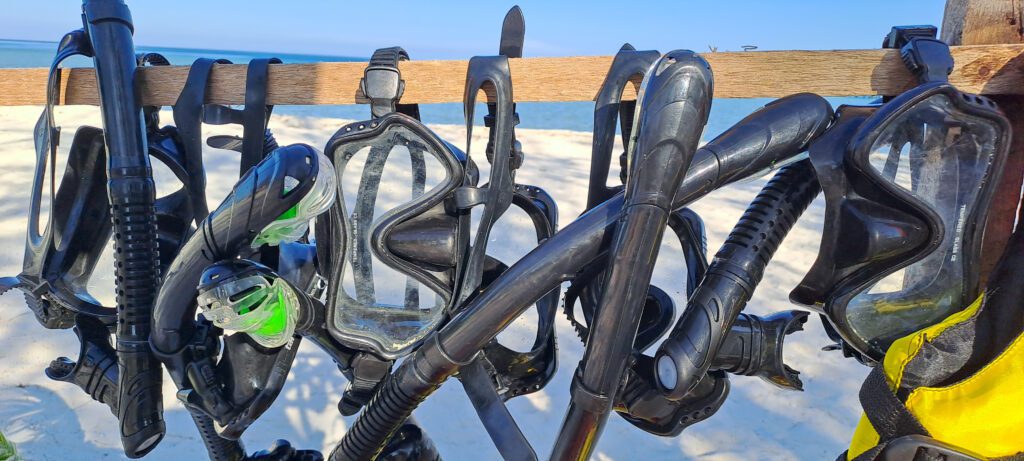Snorkeling offers a unique and captivating experience that attracts adventurers, nature lovers, and those seeking serenity. The appeal of snorkeling lies in its accessibility, the vivid beauty of the underwater world, the sense of freedom it provides, and the opportunity for personal enrichment. Having the right snorkeling equipment is crucial for enjoying snorkeling. This guide was written to help you choose ideal snorkeling equipment so you can have an enjoyable and safe snorkeling experience.

The Mask
Your snorkeling mask is your window to the underwater world so it is essential that it fits correctly. The mask is the most important piece of snorkeling equipment. Here is how to pick the perfect one:
- Fit and Comfort: A well-fitted mask should form a seal around your face without being too tight. The seal is what keeps the water from entering the mask. Test the fit by placing the mask on your face without using the strap and inhaling through your nose. If it stays in place, it is a good fit.
- Lens Type: Opt for a mask with a single or dual lens made from tempered glass for better visibility and durability. These glass masks feature shatterproof glass and they are created to withstand increased pressure if you dive deeper. Avoid plastic lenses as they can scratch easily and distort your view.
- Skirt Material: Choose a mask with a silicone skirt for comfort and durability. Silicone skirts provide a better seal and are more resistant to wear and tear than rubber ones.
Ideally, your mask should be purchased at a speciality snorkel/dive retail shop instead of online. This is because fit is crucial for a fun and successful snorkeling experience. You want to try on multiple masks to find the best fit with a knowledgeable salesperson to guide you. The mask is not where you want to choose the least expensive option.

Selecting The Snorkel
A snorkel lets you breathe while exploring underwater wonders. There are a variety of choices available. Here is what to look for:
- Dry Snorkel: A dry snorkel features a valve that prevents water from entering the tube when submerged, making it ideal for beginners and choppy conditions.
- Purge Valve: This one-way valve at the bottom of the snorkel allows you to easily expel any water that enters the tube with a simple exhale.
- Comfortable Mouthpiece: Look for a snorkel with a soft, replaceable silicone mouthpiece that fits comfortably in your mouth without causing jaw fatigue.
Make sure you can connect your snorkel to your mask. This keeps the snorkel in the correct place. Your snorkel should have a plastic hook or loop to secure it to the mask. It is easy to connect them together so do not forget this step.
Finding Fins
Fins provide greater control, efficiency, and maneuverability in the water, allowing you to swim further, and make quick turns and sudden movements without expending too much energy. Here is how to choose the best pair:
- Fit and Size: Fins should fit snugly but not too tight. They should feel comfortable not restrictive. Full-foot fins are great for warm waters, while open-heel fins paired with neoprene boots offer versatility in various conditions. Wearing neoprene socks/boots while snorkeling will really help keep you comfortable in cooler water. You will need a small amount of extra room in the foot pocket of your fin to accommodate them.
- Blade Type: Longer, flexible blades provide more power for longer swims and freediving, while shorter, stiffer blades offer better control and are easier for beginners. Most snorkelers wear short fins. Plus, shorter fins help ensure you do not kick the coral reefs.
- Material: Opt for lightweight, durable materials like rubber or silicone, which provide flexibility and strength without weighing you down.

Wetsuits
Wearing a wetsuit for snorkeling can significantly enhance your experience by providing warmth, protection, and buoyancy, allowing you to enjoy the underwater world with greater comfort and safety. A wetsuit keeps you warm and protected during snorkeling. Wearing one is particularly important in cooler climates or during extended snorkeling sessions, as it helps to maintain body heat and prevent hypothermia. Additionally, wetsuits offer a layer protection against marine life and underwater hazards, They can shield your skin form jellyfish stings, abrasions from coral or rocks, and harmful rays from the sun. The material, typically neoprene, also provides some buoyancy, making it easier to stay afloat and conserve energy while snorkeling. There are two main factors to consider when wearing a wetsuit.
- Wetsuit Thickness: Choose a wetsuit based on the water temperature and your preference. There are different thicknesses available, typically ranging from 1mm to 7mm, depending on the water temperature. A 3mm wetsuit or shorty (wetsuit with short sleeves and legs) is ideal for warm waters, while thicker suits (5mm or more) are necessary for cooler conditions.
- Fit and Comfort: Your wetsuit should fit snugly without restricting movement. A snug, but not too tight, fit ensures optimal thermal protection and comfort. Check for comfortable seams and zippers that don’t irritate your skin.
Reef Safe Sun Protection
Reef safe sun protection is essential for preserving marine ecosystems while snorkeling. Traditional sunscreens often contain chemicals harmful to coral reefs and marine life, such as oxybenzone, octinoxate, and certain parabens. These substances can cause coral bleaching, disrupt marine life reproduction, and accumulate in the environment, leading to long-term damage. To protect both your skin and the reefs, consider the following reef-safe sun protection methods:
- Reef-Safe Sunscreen: Use mineral-based sunscreens containing zinc oxide or titanium dioxide. These ingredients sit on the skin’s surface and reflect UV rays without dissolving in water or harming marine life. Look for products labeled as “reef-safe” to ensure they do not contain harmful chemicals.
- Protective Clothing: Wear UV-protective clothing such as rash guards, swim leggings, long-sleeved swimsuits or wetsuits. These garments provide effective sun protection without the need for sunscreen, reducing the risk of introducing harmful chemicals into the water.
- Wide-Brimmed Hats and Sunglasses: While not applicable while in the water, wearing wide-brimmed hats and UV-protective sunglasses before and after snorkeling helps reduce sun exposure and the need for excessive sunscreen application.
- Timing and Shade: Snorkel during early morning or late afternoon when the sun’s rays are less intense. Take breaks in shaded areas to minimize direct sun exposure during peak hours.
- Sunscreen Application: Apply reef-safe sunscreen at least 15 minutes before entering the water to allow it to fully absorb into your skin. This helps reduce the amount that washes off into the ocean.
By incorporating these reef-safe sun protection methods, snorkelers can enjoy their underwater adventures while contributing to the preservation and health of coral reefs and marine ecosystems.

Gear Maintenance and Troubleshooting
Proper maintenance ensures your gear lasts longer and performs well. Thankfully, maintaining snorkeling equipment is relatively simple and quick. Here are some tips:
- Rinse After Use: Always rinse your mask, snorkel, fins, and wetsuit with fresh water after each use to remove salt, sand, and debris.
- Dry Thoroughly: Allow your gear to air dry completely before storing it. Hang your wetsuit in a cool, shaded area and keep your mask and snorkel in a dry, ventilated space.
- Regular Inspections: Check your gear for any signs of wear and tear. Look for cracks in the mask lens, tears in the wetsuit, and any damage to the snorkel or fins. Replace damaged gear promptly to ensure safety.
- Anti-Fog Solutions: Use anti-fog sprays or solutions on your mask to prevent fogging. Alternatively, a small drop of baby shampoo rinsed off with water can work wonders.
- Troubleshooting Leaks: If your mask leaks, check the seal and adjust the strap for a better fit. Ensure no hair or debris is trapped under the skirt. For snorkels, ensure the purge valve is clear and the mouthpiece is securely attached.
Conclusion
In essence, snorkeling’s appeal lies in its blend of adventure, beauty, freedom, and connection. Whether you’re seeking a peaceful escape, an exciting adventure, or a deeper bond with nature, snorkeling offers something special for everyone. And having the correct snorkeling equipment will help ensure you have a fun and successful experience.
An extra tip for those with longer hair near your face or bangs, wearing a scuba headband is so helpful. The headband prevents hair from obstructing your vision and getting trapped in your mask while snorkeling. Plus, there are some really fun patterns on the market now for scuba headbands. I hope you feel better educated and prepared to get the essential snorkeling equipment so you can confidently enjoy your next snorkeling adventure. Have fun exploring the underwater world!

